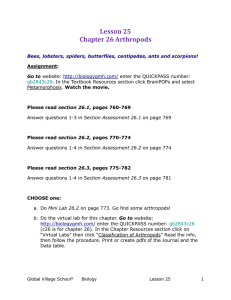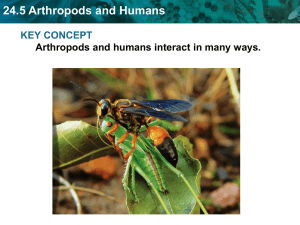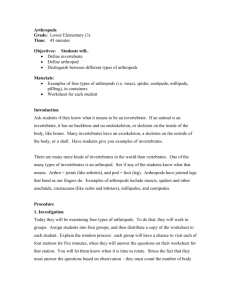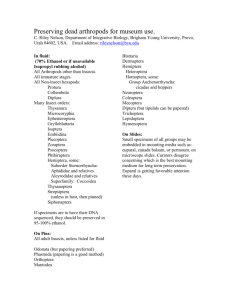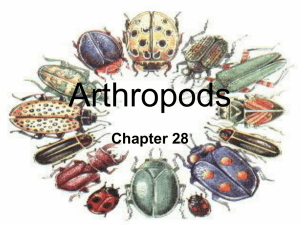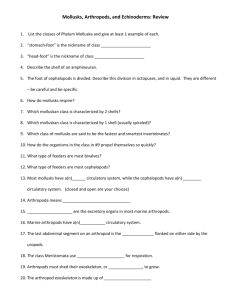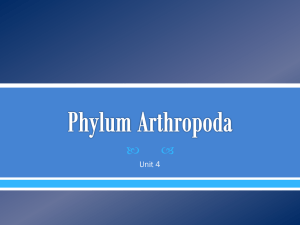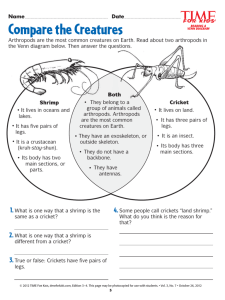محاضره 10
advertisement
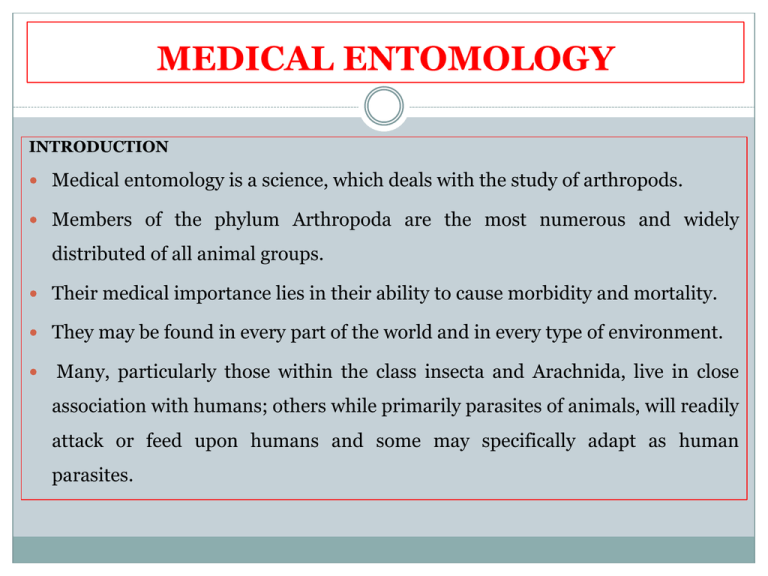
MEDICAL ENTOMOLOGY INTRODUCTION Medical entomology is a science, which deals with the study of arthropods. Members of the phylum Arthropoda are the most numerous and widely distributed of all animal groups. Their medical importance lies in their ability to cause morbidity and mortality. They may be found in every part of the world and in every type of environment. Many, particularly those within the class insecta and Arachnida, live in close association with humans; others while primarily parasites of animals, will readily attack or feed upon humans and some may specifically adapt as human parasites. ARTHROPODS All arthropods have the following characteristics in common: • They are bilaterally symmetrical. • Their bodies are divided into a number of rings or segments. • They have jointed appendages, which may take the form of legs, antennae, or mouthparts. • They have a hard chitinous exoskeleton (cuticle), which helps for the protection and insertion of muscles. • They have a body cavity, which contains haemolymph that bathes internal organs. • Ecdysis or moulting is a phenomenon characteristic of all arthropods DEVELOPMENT OF ARTHROPODS The development of arthropods, which is called metamorphosis, is from egg to adult. This development could be: Incomplete development from the egg to nymph, which looks like the adult. OR Complete development, which extends from the egg to larva, pupa that later differentiate to the adult arthropod. IMPORTANCE OF ARTHROPODS IN PARASITOLOGY Arthropods affect the health of man by being: a) Direct agents for disease /discomfort. The following effects may be seen by the direct effect of arthropods. Annoyance – comes from disruptive activities of insects, such as flying around or landing on the head, and from feeding. Entomophobia – is an irrational fear of insects. Envenomization – is the introduction of a poison into the body of humans and animals. Allergic reactions – a hypersensitive response to insect proteins. Dermatosis and dermatitis – dermatosis is a disease of the skin and dermatitis is an inflammation of the skin. (b) Agents for disease transmission Arthropods can carry disease causative agents in the following two ways. • Mechanical carrier Here they lodge the disease causative agent without altering its development or multiplication • Biological carrier When arthropods become biological carriers for transmission of disease, it means that certain stages in the life cycle of parasite takes place in the body of the insect (Anopheles). CLASSIFICATION OF ARTHROPODS There are three medically important classes of Arthropods: 1. Class Insecta- consists of mosquitoes, fleas, bugs, lice and flies, etc. 2. Class Arachnida- consists of ticks, mites and scorpion. 3. Class Crustacea- consists of cyclops. (1) Class Insecta The general feature of this class includes: • Division of body into head, thorax and abdomen. • Possess one pair of antenna on the head. • 3 pairs of legs, carried by thorax. • Wings may be present and could be one /two pairs. 2. Class Arachnida • Body divided into cephalothorax (head and thorax fused) and abdomen. • Possess 4 pairs of legs. • They are wingless • No antennae • undergo incomplete metamorphosis. 3. Class Crustacia The general feature of this class includes • Body divided into cephalothorax and abdomen • 4 pairs of legs • 2 pairs of antenna • Wingless • Most are aquatic This class includes the Cyclopes. MEDICAL CONDITIONS RELATED TO ARTHROPODS A. FLY RELATED CONDITIONS Myiasis is invasion of tissue of humans and other vertebrate animals with dipterous fly larva, which for at least a period feed upon the living, necrotic or dead tissues of animals. Pathogens can be transmitted by three possible ways: • By contaminated feet, body hairs and mouthparts of flies. • Flies frequently vomit on food during feeding this can lead to infection. • Probably the most important method of transmission is defecation, which often occurs on food. B.MOSQUITO RELATED CONDITIONS Mosquitoes cause a number of diseases in humans; the different types of mosquitoes and the parasite they transmit are listed in the following table. C. FLEA RELATED CONDITIONS Fleas can be ectoparasites, which may sometimes cause allergic dermatitis and are intermediate hosts for certain bacteria like yersinia pestis and Rickettsia typhi. D. LICE RELATED CONDITIONS Lice are usually ectoparasites, and they can live in different part of the body. E. BUG RELATED CONDITIONS Other than being ectoparasites and a nuisance to humans, bugs like Triatoma (Kissing bug) are disease vector of Trypanasoma cruzi,which is seen in some countries of Latin America. F. TICK RELATED CONDITIONS Ticks can cause mechanical injury to the skin. They may sometimes produce toxins, which affect release of acetylcholine at the neuromuscular junctions. G. MITE RELATED CONDITIONS A mite called Sarcoptes scabies causes itchy, popular eruptions in the skin usually termed as scabies. House dust mites either produce or concentrate potent allergens commonly found in non-ventilated houses. VECTOR CONTROL MEASURES (1) Mechanical methods E.g. Use of bed nets, wire mesh, etc. (2) Ecological control Ecological control procedures involve the removal, destruction, modification, or isolation of materials that might favor the survival of an insect pest by affording food or making a site suitable for breeding and/ or dormancy. e.g. draining marshy areas. (3) Chemical methods Deals with the use of natural or synthetic chemicals that directly cause the death, repulsion, or attraction of insects. E.g. use of DDT (4) Biological methods Refers to the regulation of vector population using predators, like certain species of fish, which feeds on larval stages of some arthropods, and microbial agents. (5) Genetic control Involves manipulation of the mechanisms of heredity. In some research centers sterilized male mosquitoes are used in order for them to compete with natural ones and thereby decreasing the new generation of mosquitoes.
